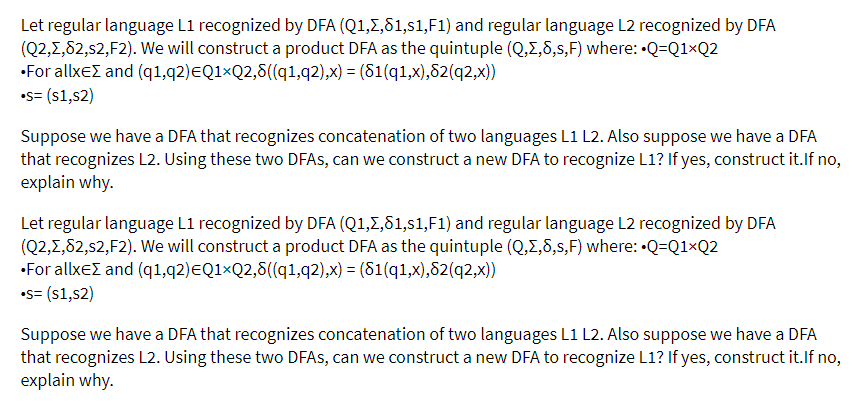Suppose we have a DFA that recognizes concatenation of two languages L1 L2. Also suppose we have a DFA that recognizes L2. Using these two DFAS, can we construct a new DFA to recognize L1? If yes, construct it.lf no,
Suppose we have a DFA that recognizes concatenation of two languages L1 L2. Also suppose we have a DFA that recognizes L2. Using these two DFAS, can we construct a new DFA to recognize L1? If yes, construct it.lf no,
Database System Concepts
7th Edition
ISBN:9780078022159
Author:Abraham Silberschatz Professor, Henry F. Korth, S. Sudarshan
Publisher:Abraham Silberschatz Professor, Henry F. Korth, S. Sudarshan
Chapter1: Introduction
Section: Chapter Questions
Problem 1PE
Related questions
Question
dont dont dont post unnecessary and existing ans else sure dislike else skip strict action

Transcribed Image Text:Let regular language L1 recognized by DFA (Q1,Z,81,s1,F1) and regular language L2 recognized by DFA
(Q2,1,82,s2,F2). We will construct a product DFA as the quintuple (Q,E,8,s,F) where: •Q=Q1×Q2
•For allxeZ and (q1,q2)EQ1×Q2,8((q1,q2),x) = (81(q1,x),82(q2,x))
•s= (s1,s2)
Suppose we have a DFA that recognizes concatenation of two languages L1 L2. Also suppose we have a DFA
that recognizes L2. Using these two DFAS, can we construct a new DFA to recognize L1? If yes, construct it.lf no,
explain why.
Let regular language L1 recognized by DFA (Q1,E,81,s1,F1) and regular language L2 recognized by DFA
(Q2,1,82,s2,F2). We will construct a product DFA as the quintuple (Q,E,8,s,F) where: •Q=Q1×Q2
•For allxeE and (q1,q2)EQ1×Q2,8((q1,q2),x) = (81(q1,x),82(q2,x))
•s= (s1,s2)
Suppose we have a DFA that recognizes concatenation of two languages L1 L2. Also suppose we have a DFA
that recognizes L2. Using these two DFAS, can we construct a new DFA to recognize L1? If yes, construct it.If no,
explain why.
Expert Solution
This question has been solved!
Explore an expertly crafted, step-by-step solution for a thorough understanding of key concepts.
Step by step
Solved in 2 steps

Knowledge Booster
Learn more about
Need a deep-dive on the concept behind this application? Look no further. Learn more about this topic, computer-science and related others by exploring similar questions and additional content below.Recommended textbooks for you

Database System Concepts
Computer Science
ISBN:
9780078022159
Author:
Abraham Silberschatz Professor, Henry F. Korth, S. Sudarshan
Publisher:
McGraw-Hill Education

Starting Out with Python (4th Edition)
Computer Science
ISBN:
9780134444321
Author:
Tony Gaddis
Publisher:
PEARSON

Digital Fundamentals (11th Edition)
Computer Science
ISBN:
9780132737968
Author:
Thomas L. Floyd
Publisher:
PEARSON

Database System Concepts
Computer Science
ISBN:
9780078022159
Author:
Abraham Silberschatz Professor, Henry F. Korth, S. Sudarshan
Publisher:
McGraw-Hill Education

Starting Out with Python (4th Edition)
Computer Science
ISBN:
9780134444321
Author:
Tony Gaddis
Publisher:
PEARSON

Digital Fundamentals (11th Edition)
Computer Science
ISBN:
9780132737968
Author:
Thomas L. Floyd
Publisher:
PEARSON

C How to Program (8th Edition)
Computer Science
ISBN:
9780133976892
Author:
Paul J. Deitel, Harvey Deitel
Publisher:
PEARSON

Database Systems: Design, Implementation, & Manag…
Computer Science
ISBN:
9781337627900
Author:
Carlos Coronel, Steven Morris
Publisher:
Cengage Learning

Programmable Logic Controllers
Computer Science
ISBN:
9780073373843
Author:
Frank D. Petruzella
Publisher:
McGraw-Hill Education